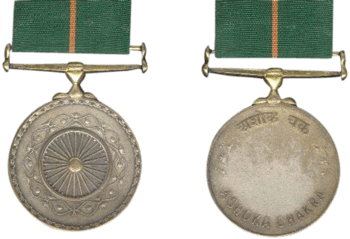Ashoka Chakra (military decoration)
| Ashoka Chakra अशोक चक्र | |
|---|---|
|
Ashoka Chakra and its ribbon, the highest peacetime decoration of India | |
|
Awarded by | |
| Country |
|
| Type | Medal |
| Eligibility |
|
| Awarded for | Awarded for most conspicuous bravery, or some act of daring or pre-eminent act of valour or self-sacrifice otherwise than in the face of the enemy.[1] |
| Status | Currently Awarded |
| Post-nominals | AC |
| Statistics | |
| Established | 1952 |
| First awarded | 1952 |
| Last awarded | 2016 |
| Total awarded | 63 |
| Posthumous awards | 8+ |
| Precedence | |
| Next (higher) | Param Vir Chakra[2] |
| Next (lower) | Padma Vibhushan[2] |
The Ashoka Chakra (alternative spelling: Ashok Chakra) is India's highest peacetime military decoration awarded for valour, courageous action or self-sacrifice away from the battlefield. It is the peace time equivalent of the Param Vir Chakra, and is awarded for the "most conspicuous bravery or some daring or pre-eminent valour or self-sacrifice" other than in the face of the enemy. The decoration may be awarded either to military or civilian personnel. Ashok Chakra is equivalent to US Army's peacetime Medal Of Honor and the British George Cross.[3]
Flt. Lt. Suhas Biswas was the first Indian Air Force officer to be awarded the Ashoka Chakra. Subsequent awards of the Ashoka Chakra are recognized by a bar to the medal ribbon. A recipient can be awarded the Kirti Chakra or Shaurya Chakra in addition for separate acts of gallantry.
History
The medal was originally established on 4 January 1952 as the "Ashoka Chakra, Class I" as the first step of a three-class sequence of non-combatant bravery decorations. In 1967, these decorations were removed from the "class-based" system and renamed as the Ashoka Chakra, Kirti Chakra, and Shaurya Chakra. This is an important point in understanding the independent Indian view of decorations. It would also lead to changes in the Padma Vibhushan series, the distinguished service medal series, the life saving medal series, and the Defence Security Corps medal series.
From 1 February 1999, the central government instituted a monthly stipend for Ashoka Chakra recipients of Rs. 1400. Jammu and Kashmir awarded a cash award of Rs. 1500 (ca. 1960) for recipients of this award.
Overview
Obverse: Circular gold gilt, 1-3/8 inches in diameter. In the center, the chakra (wheel) of Ashoka, surrounded by a lotus wreath and with an ornate edge. Suspended by a straight bar suspender. The medal is named on the edge.
Reverse: Blank in the center, with "Ashoka Chakra" in Hindi along the upper edge on the medal and the same name in English along the lower rim. On either side is a lotus design. The center is blank, perhaps with the intent that details of the award be engraved there. There is no indication of the class on the pre-1967 awards, and, in fact, there is no difference between these medals and the post-1967 awards.
Ribbon: 32 mm, dark green with a 2 mm central saffron stripe.
To date, 63 people have been awarded the "Ashoka Chakra".
Ashoka Chakra recipients
| # | Indicates a posthumous honour |
References
- 1 2 http://www.indianarmy.gov.in/Site/FormTemplete/frmTempSimple.aspx?MnId=p6xUHC5yMgV3Tyuw9ZIb6w==&ParentID=tFRV4t12pKRhSFm2sMq5yQ==
- 1 2 "Precedence Of Medals". http://indianarmy.nic.in/. Indian Army. Retrieved 9 September 2014. External link in
|work=(help) - ↑ Peacetime Military Awards
- 1 2 3 4 5 6 7 8 9 "Ashoka Chakra recipients (2009–16)". Indian Army Web Portal. Retrieved 18 January 2017.
- ↑ "The President, Shri Pranab Mukherjee giving away the highest gallantry award Ashok Chakra to Shri K. Venkatraman father of the Reserve Inspector, Govt. of Andhra Pradesh, Shri K.L.V.S.S.H.N.V. Prasad Babu, (Posthumous), during the 65th Republic Day Parade 2014, in New Delhi on January 26, 2014.". Press Information Bureau, India. 26 January 2014. Retrieved 18 January 2017.
- 1 2 3 4 5 6 7 8 9 10 11 "Ashoka Chakra awardees and their saga of gallantry" (Press release). Press Information Bureau, India. 25 January 2009. Retrieved 18 January 2017.
- 1 2 3 4 5 6 7 8 9 10 11 12 13 14 15 16 17 "Ashoka Chakra recipients (1993–2009)". Indian Army Web Portal. Retrieved 18 January 2017.
- 1 2 3 4 5 6 7 8 9 10 11 12 13 14 15 16 17 18 19 20 21 "Ashoka Chakra recipients (1952–92)". Indian Army Web Portal. Retrieved 18 January 2017.
External links
- Ashoka Chakra at Indian Army website
- Bharat Rakshak Page on Ashoka Chakra
- Ashoka Chakra awardees of the Indian Air Force
- Recipients of Ashoka Chakra Award
